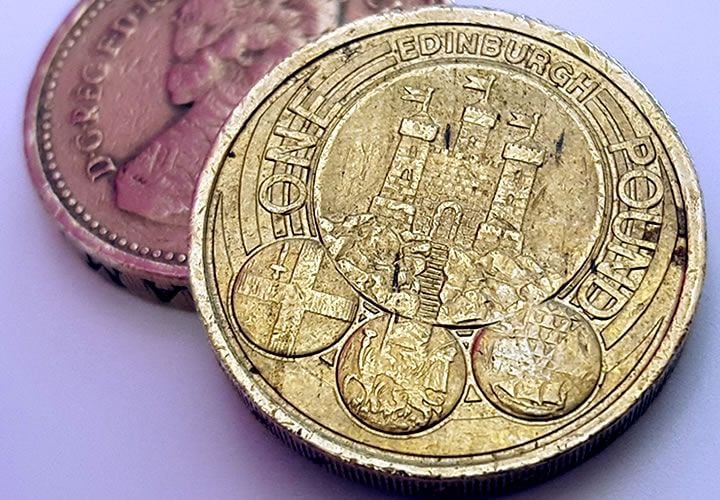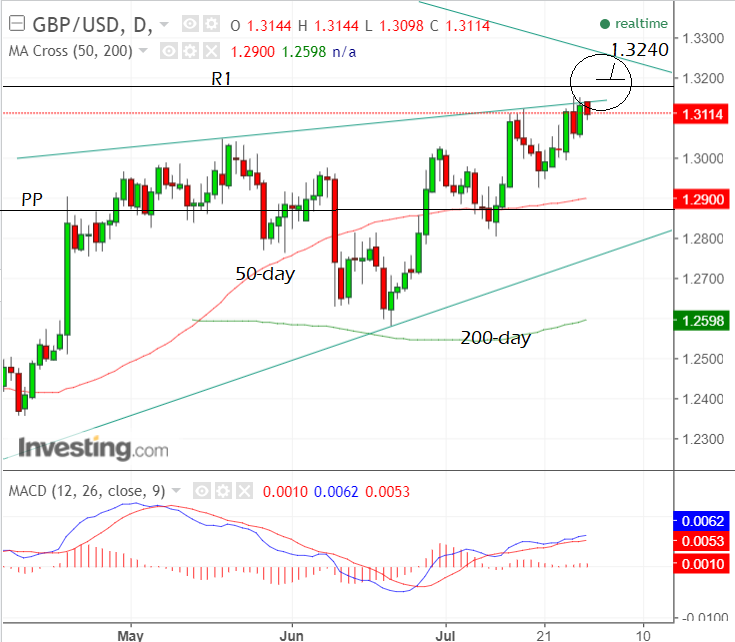GBP/USD Exchange Rate Faces Key Resistance Levels and Overbought Conditions

The Pound to Dollar exchange rate continues to move higher with a fresh multi-month high being triggered today with 1.3233 being tested.
The gains come amidst a broader atmosphere of US Dollar weakness with some commentators suggesting further signs of political turbulence at the White House are to blame for the USD's underperformance.
Overnight, communications director Anthony Scaramucci was removed after just 10 days with he move said to be at the behest of the new White House Chief of Staff John Kelly. Some see this as a sign of chaos, but it could also be the point at which discipline was finally imposed on the trouble administration.
We find little reason to question the uptrend in GBP/USD at this stage but some analysts are becoming nervous.
"The trend extends with the broader USD still under pressure. 1.3255-65 is still seen as resistance on the day to be mindful of, with intra-day studies becoming a little "overbought" suggesting a corrective pullback can be seen, as has been the case with moves to new highs," says analyst Robin Wilkin at Lloyds Bank.
Whilst the short-term uptrend is intact the pair is also reaching several tough resistance levels which are likely to obstruct further upside.
The first of these is a type of trend channel line which is situated at the current market highs, linking the May and June highs at 1.3145.

Even if this is broken through, however, there is a strong possibility that the exchange rate will stumble at the next hurdle, the 1.3175 resistance level provided by the R1 monthly pivot.
Monthly pivots are calculated from the previous month’s open high low and close and gives traders an idea of whether the market is over-extended or not.
They are often the locus of increased supply or demand as more traders enter the market to push it higher or lower – often in the direction counter to the dominant trend.
A break above the pivot, confirmed by a move above 1.3200 would probably lead to a continuation up to a target at 1.3240, and the major long-term trendline situated there.
The trendline will probably prove the toughest level to break and the exchange rate and there is a material chance the pair could reverse of consolidate following contact with the trendline.
Get up to 5% more foreign exchange by using a specialist provider. Get closer to the real market rate and avoid the gaping spreads charged by your bank for international payments. Learn more here.
Data for the Dollar
Data starts with Pending Home Sales for June, released on Monday, July 31, at 15.00 BST.
A major gauge of manufacturing in the US, ISM Manufacturing PMI is out at 15.00 BST on Tuesday August 1, and is expected to show a decline to 56.5 from 57.8 previously.
The Federal Reserve’s preferred method of measuring inflation – Personal Consumption Expenditure is also out on Tuesday, but at 13.30.
It is expected to show PCE creeping up by 1.4% annually (from 1.3%) previously and 0.1% month-on-month in June.
ADP Payrolls is released on Wednesday August 3, but the big release comes at the end of the week, when Non-Farm Payrolls are released at 13.30 on Friday August 5.
“We expect a solid 190k print, taking into account risk for a sharp pullback in government jobs as labor market indicators on balance point to a 200k+ gain. A lower unemployment rate (4.3% vs 4.4%) and solid 0.3% gain on avg hourly earnings should garner a hawkish market reaction,” commented Canadian investment bank, TD Securities in a note on the week ahead.
This Week's Data and Events for the Pound
The Bank of England (BOE) rate meeting is the main release for the Pound in the week ahead.
The meeting, scheduled at 12.00 BST on Thursday, August 3, is not expected to result in a change of policy, despite the relatively close vote of 5-3 not to raise interest rates at the previous meeting.
“There has been a lot of speculation that the BoE is about to change tack. But, for now, policy still seems set to remain on hold,” said Lloyds Commercial Banking’s, chief economist, Rhys Herbert, who forecasts a 6-2 split in favour of keeping interest rates unchanged.
TD Securities agree with the view that the BOE will vote 6-2 to stay on hold:
“While the BoE took a more hawkish stance in June with a 3 MPC members voting for a hike, we look for a 6-2 vote this time as the uber-hawk Forbes departs and most top-tier data has surprised to the downside since Haldane’s hawkish speech in June.”
Recent strong GDP data is probably not going to be enough to encourage a rate rise, despite coming out up by 0.3% on the previous month – against 0.2% forecast – and 1.7% higher on an annualized basis as this is still well below the rate of inflation which is circa 2.7%.
RBS’s chief economist notes how the dominant Services sector is holding overall growth up.
He adds that there are two schools of thought about this, with the first composed of optimists, for whom, “the strength of the service sector, representing 80% of the economy, shows the underlying resilience of growth with services now 2.3% bigger than a year ago,” whilst pessimists argue that the, “falls in production output are being masked by a short-lived expansion of services that’s doomed to fall victim to the real income squeeze.”
The BOE’s quarterly inflation report will also be released on Thursday, however, the consensus estimate is for little change to forecasts.
The other major releases for the Pound in the week ahead are manufacturing, construction and services PMI’s released.
The data should give a snapshot as to whether the uptick in economic activity seen in the second-quarter of 2017 is extending into the third-quarter.
Tuesday's manufacturing PMI is forecast to read at 54.4, up from the previous month's 54.3.
Wednesday's manufacturing PMI is forecast to read at 54.5, down from a previous 54.8.
The most important of this data series comes on Thursday with the release of service sector PMI which is forecast to read at 53.6, up from a previous 54.3.




